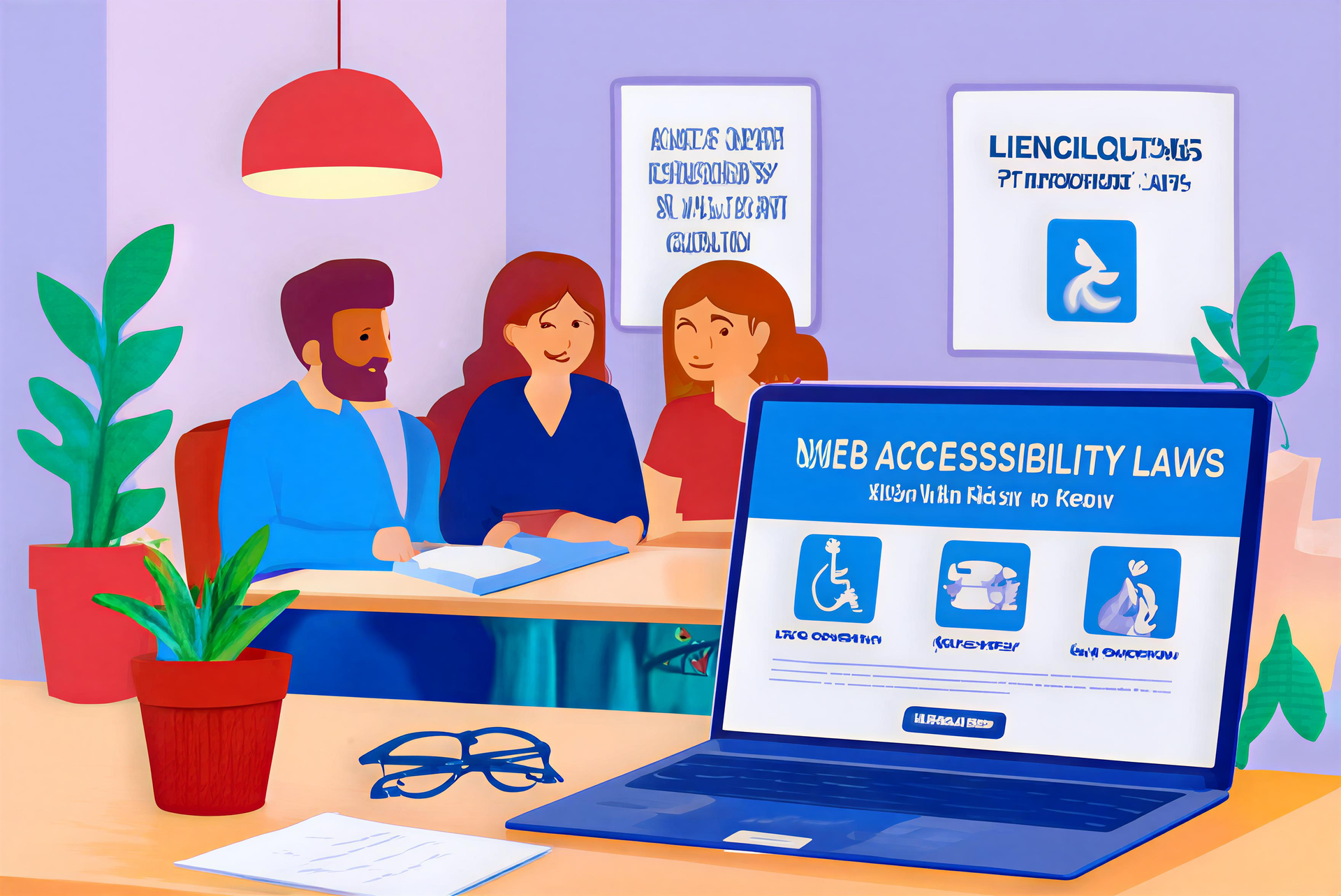Navigating Web Accessibility Laws: What You Need to Know
Welcome! We're glad you're here to explore the world of digital inclusion. For any business today, understanding online legal requirements is no longer optional. It's a core part of operating responsibly and successfully.

Creating an inclusive online space isn't just about goodwill. It connects directly to legal compliance, expanding your audience, and shielding your company from potential risks. What began as voluntary best practices have now become serious legal obligations in many places.
This guide will walk you through everything. We'll start with the basic principles that make digital
content usable for everyone. Then, we'll look at specific laws and show you practical steps for implementation.
Our goal is to make these complex rules clear and manageable for organizations of all sizes. We believe everyone deserves equal access to online
information. Companies like EZPages.Pro are built to help businesses meet these challenges head-on with services that build inclusivity from the start.
Key Takeaways
- Understanding digital inclusion laws is essential for modern business operations.
- Legal compliance helps you reach a broader audience and avoid potential lawsuits.
- Voluntary guidelines have evolved into enforceable legal requirements globally.
- This guide covers fundamental principles, legal frameworks, and practical steps.
- Demystifying complex regulations provides actionable insights for all business sizes.
- Professional services can help prioritize inclusivity from the ground up.
Introduction to Web Accessibility Laws
Legal frameworks now mandate equal online access for all individuals. Countries worldwide have adopted specific rules to ensure digital inclusion. These regulations create obligations for businesses and organizations.
Overview of Key Legal Frameworks
The United States leads with important legislation. The Americans with Disabilities Act (ADA) Title III applies to private businesses. It requires websites to meet specific accessibility guidelines.
Section 508 of the Rehabilitation Act covers federal entities. It mandates that government websites and funded projects follow strict requirements. Both laws aim to serve people with disabilities effectively.
Internationally, similar frameworks have emerged. The European Accessibility Act requires compliance by June 2025. Canada's AODA and ACA laws also enforce current standards.
| Country/Region | Key Legislation | Compliance Deadline |
|---|---|---|
| United States | ADA Title III, Section 508 | Ongoing |
| European Union | European Accessibility Act | June 2025 |
| Canada | AODA, ACA | Phased implementation |
| Australia | Disability Discrimination Act | Active |
Importance for Modern Businesses
Ignoring these requirements carries serious consequences. Non-compliance leads to lawsuits, fines, and reputational damage. Approximately 15-20% of the global population has disabilities.
This represents a massive market segment that businesses cannot afford to exclude. Proper compliance demonstrates corporate responsibility while expanding customer reach.
EZPages.Pro understands these complex requirements thoroughly. We design, maintain, and host websites tailored for companies and startups. Our services build compliance directly into your digital presence from the start.
Business owners can focus on growth while we handle technical requirements professionally. This comprehensive approach ensures your web content meets all current guidelines effectively.
Web Accessibility Standards: Guidelines and Best Practices
International specifications provide the blueprint for barrier-free online experiences. These technical requirements ensure digital materials work for people with diverse needs. They cover visual, auditory, physical, and cognitive considerations.
The Web Content Accessibility Guidelines (WCAG) serve as the globally recognized framework. Most legislation references these specifications for compliance. WCAG 2.2 became official in October 2023 with nine new criteria.
Following these principles makes
content perceivable, operable, understandable, and robust. Perceivable means users can identify elements through different senses. Operable ensures functionality works with various input methods.
Understandable requires clear navigation and predictable interactions. Robust means compatibility with current and future technologies. These foundations create experiences that work for everyone.
Best practices include text alternatives for images and proper color contrast. Keyboard navigation and clear structure benefit all users. Mobile users and older adults gain advantages alongside people with disabilities.
Businesses benefit from better search rankings and broader audience reach. Implementing these
guidelines early proves more cost-effective than later fixes. They represent smart business strategy beyond mere compliance.
The Evolution and History of Web Accessibility Guidelines
The journey toward inclusive digital experiences began with a simple observation at a global conference. Following Tim Berners-Lee's mention of disability access at the 1994 World Wide Web conference, Gregg Vanderheiden compiled the first official guidelines in January 1995.
This initial effort sparked widespread attention. Over 38 different guidelines emerged from various authors and organizations. The resulting confusion highlighted the need for unified direction.
Early Guidelines to WCAG 1.0
University of Wisconsin-Madison researchers brought these scattered recommendations together. Their Unified Web Site Accessibility Guidelines became the foundation for something bigger. Version 8 from 1998 served as the direct starting point for WCAG 1.0.
The World Wide Web Consortium established the Web Accessibility Initiative to formalize these efforts. They published WCAG 1.0 on May 5, 1999. This version featured 14 guidelines with 65 checkpoints organized by priority levels.
Transition Through WCAG 2.0 to 2.2
WCAG 2.0 arrived in December 2008 as a major overhaul. It reorganized guidelines around four core principles with testable success criteria. This framework became an ISO international standard in 2012.
Subsequent updates maintained backward compatibility while addressing new challenges. WCAG 2.1 added 17 success criteria focusing on mobile use and cognitive needs. The October 2023 release of WCAG 2.2 introduced nine more criteria for modern interactions.
Today, WCAG 3.0 development continues with working drafts updated through December 2024. This evolution mirrors the internet's growth from simple documents to complex applications. Each version reflects changing technology while maintaining core inclusion values.
ADA Compliance and Legal Requirements in the United States
U.S. businesses face specific legal obligations for digital inclusion under landmark legislation. These rules ensure equal access for all individuals, including people with disabilities. Understanding these requirements helps companies avoid legal trouble.
Section 508, ADA Title III, and Recent DOJ Updates
The Americans with Disabilities Act (ADA) Title III affects private companies nationwide. Courts have consistently ruled that websites must provide equal access to goods and services. This interpretation makes digital compliance essential for business operations.
Section 508 of the Rehabilitation Act sets different
requirements. It applies to federal agencies and federally-funded
organizations. A major 2017 update incorporated WCAG 2.0 standards for clear technical
requirements.
Recent Department of Justice actions have strengthened these rules. The April 2024 ruling established WCAG 2.1 Level AA as the standard for government
content. This creates important precedents for private
organizations.
Legal Implications for Non-Compliance
Failing to meet these requirements carries serious consequences. Lawsuits can cost businesses $10,000 to over $100,000 in settlements. Attorney fees and mandatory fixes add to the financial burden.
Specialized law firms actively scan websites for violations. Any business with an inaccessible website becomes a potential target. Beyond financial penalties, reputation damage can be significant.
Court-ordered audits and ongoing monitoring may result from lawsuits. More importantly, exclusionary
content prevents
people with disabilities from accessing services. Proactive
compliance protects both customers and businesses.
International Legislation and Accessibility Requirements
The European Union and Canada have established comprehensive digital access requirements that create important obligations for international businesses. These rules ensure equal access to digital content for all people, including those with disabilities.
Europe's landmark legislation, the European Accessibility Act (EAA), became legally applicable on June 28, 2025. This broad regulation covers websites, mobile apps, ebooks, ecommerce platforms, and PDF documents.
European Accessibility Act (EAA) and EN 301 549
The EAA applies to both public and private organizations operating in EU member states. It requires digital products and services to meet WCAG 2.1 Level AA standards.
EN 301 549 serves as the European standard specifying technical requirements. This document incorporates WCAG criteria while adding some Europe-specific obligations.
Earlier EU Directive 2016/2102 already mandated that public sector
websites and mobile applications conform to these same guidelines. This created mandatory
compliance for government entities across Europe.
Canadian Accessibility Laws (ACA and AODA)
Canada maintains two significant pieces of legislation governing digital access. The Accessibility for Ontarians with Disabilities Act (AODA) was ratified in 2005.
AODA requires Ontario-based
websites to achieve WCAG 2.0 Level AA conformance. Penalties for non-compliance can reach $50,000 daily for individuals and $100,000 for corporations.
The federal Accessible Canada Act (ACA) extends
requirements beyond Ontario to nationwide sectors. Banking, transportation, and telecommunications
organizations must ensure their digital
content meets accessibility guidelines.
Following WCAG 2.1 Level AA provides a solid foundation for most international jurisdictions. This approach helps
people with diverse needs access your digital materials effectively.
Key Principles of WCAG and How They Shape Accessibility
At the heart of digital inclusion efforts lie four essential concepts that determine whether
content can be used by everyone. These foundational
principles—Perceivable, Operable, Understandable, and Robust—form the POUR framework guiding all
web content accessibility efforts.
Perceivable, Operable, and Understandable
The Perceivable principle ensures information reaches users through multiple senses. This means providing text alternatives for images and captions for audio content. Content must adapt to different presentation methods without losing meaning.
Operable requirements focus on interface functionality. All features should work with keyboard navigation, not just mouse clicks. Users need sufficient time to interact with materials and avoid flashing elements that could cause seizures.
Understandable
guidelines make
content clear and predictable. Consistent site structure helps
users learn how to navigate efficiently. Clear instructions and error messages prevent confusion during interactions.
Robust Content Standards
The Robust principle ensures materials work with current and future assistive technology. Well-formed code allows screen readers and other tools to interpret content correctly. This future-proofs your digital materials against technology changes.
These four
principles work together seamlessly. A website might have perceivable images but fail if
navigation isn't keyboard-operable. Following all POUR
guidelines creates truly inclusive experiences for every
user.
Accessibility Testing Tools and Techniques
Identifying digital barriers requires specialized testing approaches that go beyond basic quality checks. These methods help ensure your online materials work for everyone regardless of their abilities.
Effective evaluation combines automated scanning with manual audits. No single method catches all potential issues, making a blended approach essential for comprehensive coverage.
Automated Scanning and Compliance Checkers
Automated tools quickly scan your web pages for technical violations. They excel at finding missing alt text, color contrast problems, and heading structure errors.
These scanners provide immediate feedback on WCAG compliance status. However, they typically detect only 30-40% of potential barriers. Human judgment remains crucial for nuanced issues.
Manual Audits and User Testing Methods
Manual testing involves keyboard-only navigation to ensure all interactive elements work without a mouse. Developers also use screen readers like JAWS and NVDA to experience content as blind users do.
The gold standard involves testing with people who have actual disabilities. Real user feedback provides insights that technology alone cannot replicate. This approach validates your digital materials in practical scenarios.
Regular monitoring is essential since websites constantly evolve. Testing should occur throughout development, not just before launch. This proactive strategy prevents barriers from affecting your audience.
Integrating Web Accessibility into Your Business Strategy
Building an inclusive digital presence requires weaving accessibility considerations directly into your business DNA from the very beginning. This approach transforms compliance from a checklist into a core value that benefits everyone.
The most effective strategy adopts a "shift left" mentality. This means considering diverse needs during initial planning rather than fixing problems later. Early integration prevents costly redesigns and creates better experiences for all visitors.
Designing for Inclusivity from the Start
Inclusive design begins with understanding how different people interact with your materials. Consider various abilities during wireframing, visual design, and content creation. This proactive thinking leads to innovative solutions that serve broader audiences.
Make digital inclusion everyone's responsibility across your organization. Train designers on inclusive principles and educate developers on proper coding techniques. Content creators should learn clear communication methods that help all readers.
Key business advantages emerge from this integrated approach:
- Reduced legal exposure and compliance risks
- Expanded market reach to diverse user groups
- Improved search visibility through better content structure
- Enhanced brand reputation as an inclusive leader
Establish clear guidelines within your design system to maintain consistency. Simple choices like clear navigation and readable text improve experiences for mobile users, older adults, and people in challenging environments. This strategic integration demonstrates true corporate responsibility while future-proofing your digital assets.
How EZPages.Pro Enhances Web Accessibility
EZPages.Pro stands out by embedding inclusive design directly into every website project from inception. Our comprehensive design, maintenance, and hosting services make digital inclusion a core feature rather than an optional extra.
We integrate Userway, a powerful tool that adds enhanced features for visitor customization. This solution offers text size adjustment, color contrast changes, and keyboard navigation assistance.
Userway Integration for Enhanced Features
The combination of accessible code foundation plus Userway's tools creates a multi-layered approach. This ensures your content reaches all users, including those with various disabilities.
Our team handles all updates and compliance monitoring proactively. Business owners can focus on growth while we manage the technical details. This approach reduces legal risk while expanding customer reach.
EZPages.Pro stays current with evolving requirements to maintain compliance as guidelines change. We provide peace of mind through our understanding of both technical and legal implications.
Ready to make your digital presence inclusive?
Book an appointment at
https://www.ezpages.pro/book-appointment or call us at
(310) 421-0433. Let us help you create websites that work for everyone.
Comprehensive Website Management for Accessibility Success
True digital inclusion extends far beyond the initial website launch. EZPages.Pro provides complete management services that handle every aspect of your online presence. This approach lets business owners concentrate on growth while professionals manage technical requirements.
Our end-to-end solution covers design, hosting, maintenance, and continuous improvement. We tailor services specifically for companies and startups of all sizes. The integrated system makes updating content simple for non-technical team members.
Regular maintenance includes crucial elements that protect your investment:
- Automatic compliance monitoring as guidelines evolve
- Security updates and performance optimization
- Integrated analytics tracking user behavior
- Barrier identification through data-driven insights
This comprehensive approach prevents new content or features from accidentally creating barriers. Professional oversight ensures your page remains inclusive through all updates. The single-provider model proves more cost-effective than separate specialists.
EZPages.Pro delivers peace of mind through accountable management. Your
information stays accessible while you focus on serving customers. This strategic partnership creates a robust digital presence that grows with your business.
Content Accessibility Guidelines: Best Practices
Your text, images, and multimedia elements form the foundation of an accessible online presence. These practical content accessibility guidelines help ensure everyone can engage with your materials effectively.
Following these daily rules makes your
information available to diverse audiences. They cover everything from simple text adjustments to complex multimedia requirements.
Adapting Text, Images, and Multimedia
Start with descriptive alt text for every meaningful image. This conveys the same information to screen reader users that visuals provide to sighted visitors. Keep descriptions concise but complete.
For text readability, ensure strong color contrast between foreground and background. Use clear, simple language that's easy to understand. Proper heading structure helps users navigate your
page efficiently.
Multimedia requires synchronized
captions for
video content and transcripts for
audio materials. These additions benefit deaf users, non-native speakers, and people in sound-sensitive environments.
Remember that accessible
content is simply good
content. Clear organization and thoughtful presentation help all visitors, not just those with specific needs.
The Role of Analytics in Monitoring Web Accessibility
Your website analytics hold hidden clues about how accessible your digital presence truly is. These tools track real behavior patterns that formal testing might overlook. They reveal how people actually navigate your materials.
Metrics like bounce rates and time on page provide immediate feedback. When visitors leave quickly from certain sections, it often signals navigation difficulties. Similarly, abandoned forms or repeated clicks on non-functional elements indicate usability barriers.
Segmenting data by device type or user group reveals important differences. You might discover higher exit rates from screen reader users or mobile visitors. This
understanding helps prioritize improvements where they matter most.
EZPages.Pro integrates comprehensive analytics tracking directly into our management services. This continuous monitoring provides actionable insights for enhancing both inclusion and overall experience. The system identifies struggling
users before they become frustrated.
Establish baseline metrics before making changes, then measure improvements. This approach demonstrates the business impact of your efforts. Analytics create a valuable feedback loop for ongoing optimization.
Ultimately, this data-driven method complements technical compliance checks. It ensures your
content works effectively for everyone in real-world scenarios.
Adapting Your Website for Diverse Disabilities
The most effective digital spaces accommodate various needs through thoughtful design choices. Different disabilities require specific approaches to ensure everyone can engage fully.
Understanding these diverse requirements helps create truly inclusive experiences. Each type of disability benefits from tailored solutions.
Designing for Vision, Hearing, and Cognitive Needs
Visual accommodations include screen reader compatibility and proper contrast ratios. Text alternatives for images help blind users understand visual content.
For hearing needs, synchronized
captions make
video and
audio materials accessible. Transcripts provide additional support for complex
content.
Cognitive considerations involve clear language and predictable navigation. Simple
text structure helps all visitors understand information better.
"Good design enables, bad design disables. When we create with diverse abilities in mind, everyone benefits."
Keyboard navigation serves multiple groups effectively. People with motor limitations and visual impairments both rely on this feature.
| Disability Type | Key Accommodations | Primary Benefits |
|---|---|---|
| Visual Impairments | Screen reader support, high contrast, text alternatives | Access to visual content, better readability |
| Hearing Limitations | Captions, transcripts, visual alerts | Understanding audio/video materials |
| Cognitive Needs | Clear language, consistent layout, simple navigation | Easier comprehension, reduced confusion |
Many solutions overlap, creating broader benefits. Thoughtful design ultimately serves all visitors more effectively.
Overcoming Common Challenges in Web Accessibility Adoption
Many businesses encounter unexpected hurdles when implementing inclusive digital practices. Despite good intentions, organizations face budget constraints, technical complexity, and internal resistance.
A major misconception involves cost concerns. While fixing existing sites can be expensive, building inclusive features from the start adds minimal expense. This approach proves more cost-effective than later retrofitting.
Limited
understanding among stakeholders presents another barrier. Some team members may not recognize which
user groups benefit from inclusive design. Demonstrating the business case helps overcome resistance.
Technical complexity often challenges
developers unfamiliar with inclusive coding practices. Legacy systems may contain structural barriers requiring significant updates. Training and specialized partnerships address these skill gaps effectively.
Ongoing maintenance requires continuous attention as
content changes and guidelines evolve. Integrating testing into workflows creates sustainable practices. Quick wins build momentum before tackling complex
levels of compliance.
Progress matters more than perfection. Even small improvements benefit
user experiences significantly. Starting the journey creates positive momentum for lasting change.
Key Takeaways for Future-Proofing Your Website's Accessibility
Creating lasting digital inclusion means building systems that adapt to new
guidelines and
user needs. This requires ongoing commitment rather than one-time fixes.
Establish clear policies that make expectations explicit across your organization. Regular audits using both automated tools and manual testing help identify issues early.
Strategic Recommendations for Ongoing Compliance
Build reusable components that have been tested for various levels of compliance. This ensures consistency while reducing repetitive problem-solving.
Stay informed about evolving requirements as technology advances. WCAG 3.0 development signals upcoming changes that forward-thinking teams should prepare for.
Invest in training for everyone who touches digital content. From designers to developers, proper understanding creates better experiences for all visitors.
"Good accessibility is good business. When we design for everyone, we create better products for everyone."
Document your efforts to demonstrate commitment. This shows good faith while creating valuable institutional knowledge.
Partner with experts who handle technical implementation as
requirements change. This approach maintains compliance while letting you focus on core business goals.
Conclusion
Building websites that serve everyone starts with recognizing the value of universal design. Throughout this guide, we've explored how digital inclusion combines legal obligations with smart business practices.
Following established guidelines benefits all users while protecting your organization. People with disabilities gain equal access to your content, and your business reaches wider audiences.
Compliance with current
requirements safeguards against legal challenges. The POUR principles provide a clear framework for creating inclusive digital experiences.
EZPages.Pro makes this process straightforward with comprehensive services. Our team handles design, maintenance, and compliance monitoring using tools like Userway.
Don't wait for challenges to arise.
Book an appointment at
https://www.ezpages.pro/book-appointment or call
(310) 421-0433 today. Together, we can create online spaces where everyone accesses
information freely and engages equally.
Frequently Asked Questions About Navigating Website Content Accessibility
What are the main web content accessibility guidelines I should follow?
The most widely recognized rules are the WCAG guidelines from the World Wide Web Consortium. These principles help make your online material usable for people with various disabilities. Following them is a best practice for creating an inclusive experience.
How do I know if my website meets legal requirements?
In the United States, laws like the ADA and Section 508 set the bar. Many organizations use the WCAG standards as a benchmark for compliance. It's wise to perform regular checks using both automated tools and manual audits to ensure you're meeting all obligations.
What are some simple changes I can make to improve content accessibility?
Start by adding text descriptions for all images. Ensure there is enough color contrast between your text and background. Provide captions for videos and make sure all functions can be used with a keyboard. These steps make a big difference for users.
Why is it important for my business to focus on this?
Making your digital products accessible opens your services to a wider audience, including millions of people with disabilities. It also helps protect your organization from legal risk and demonstrates a commitment to social responsibility.
Can automated tools check everything for me?
While automated scanners are helpful for finding some issues, they can't catch everything. A thorough approach combines technology with manual testing and feedback from real users, including those who rely on assistive technology.
How does EZPages.Pro help with these guidelines?
EZPages.Pro integrates with solutions like Userway to provide features that enhance usability. This partnership helps businesses more easily implement changes that align with key principles, making content more perceivable and operable for everyone.
EzPages.Pro specializes in small business web management and web development for small businesses and startups. Our tailored solutions simplify content updates, track performance with analytics, and ensure smooth site operation. With our all-in-one management services, you can focus on growing your business while we handle the rest.
🚀 Let’s build something great together.



